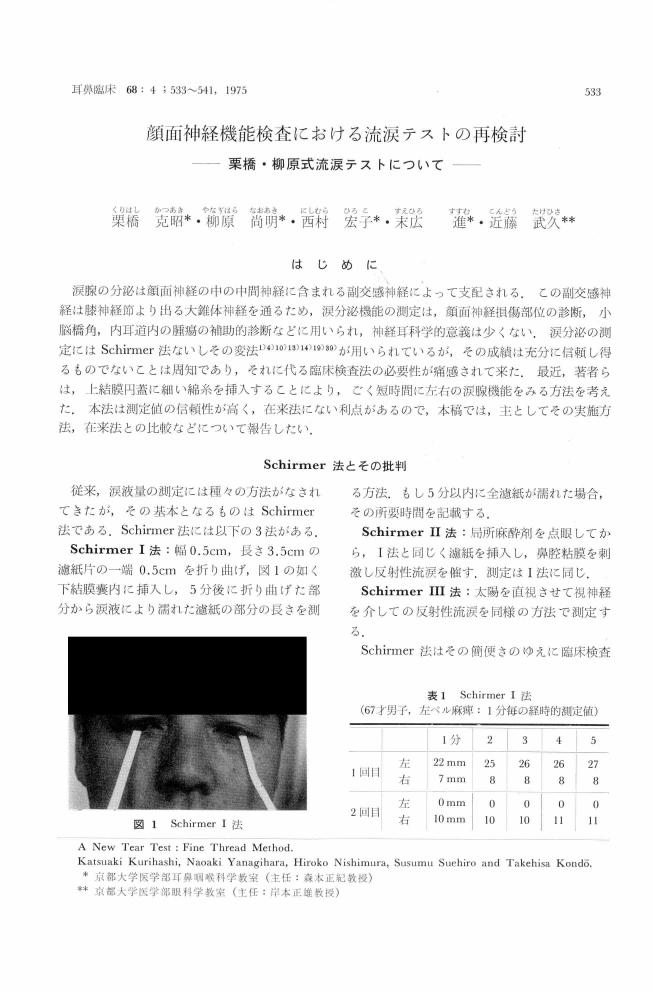- 著者
- 小松崎 篤 冨田 寛 柳原 尚明 神崎 仁 齋藤 春雄 青柳 優 龍 浩志
- 雑誌
- Facial nerve research (ISSN:0914790X)
- 巻号頁・発行日
- vol.15, pp.227-230, 1995-12-10
- 被引用文献数
- 37
1 0 0 0 OA 聴神経腫瘍のめまい症状について
- 著者
- 佐伯 忠彦 暁 清文 山中 栄三 柳原 尚明
- 出版者
- Japan Society for Equilibrium Research
- 雑誌
- Equilibrium Research (ISSN:03855716)
- 巻号頁・発行日
- vol.47, no.4, pp.428-433, 1988 (Released:2009-10-20)
- 参考文献数
- 15
- 被引用文献数
- 1
Vestibular findings were studied in 27 patients with acoustic neurinoma. Four of them had experienced vertigo and/or dizziness at the onset of the disease, and 14 other patients had these complaints during the course. Vestibular symptoms were more prominent with middle-sized tumors which extended to the posterior cranial fossa than with those in the internal auditory canal. Although most acoustic neurinomas originate from the vestibular nerve, the incidence of vestibular symptoms is rather infrequent. This is probably due to a compensating mechanism of the central nervous system while the tumor grows slowly. Therefore, the growth rate of the tumor is considered to be most important for the concomitance of vestibular symptoms. The origin of the tumor was identified in 13 cases; in 3 it was from the inferior vestibular nerve and in 10 from the superior vestibular nerve. No significant difference in caloric test results could be seen between the tumors of different origins. The incidence of vestibular symptoms was more frequent when the tumor originated from the superior vestibular nerve than from the inferior vestibular nerve. The recover time required from the dysequilibrium after extirpation of the tumor depended on the degree of preoperative vestibular function.
1 0 0 0 OA 脳梗塞による突発難聴の3症例
- 著者
- 小林 泰輔 暁 清文 柳原 尚明 松本 康 町田 敏之 堀内 譲治
- 出版者
- 耳鼻咽喉科臨床学会
- 雑誌
- 耳鼻咽喉科臨床 (ISSN:00326313)
- 巻号頁・発行日
- vol.86, no.3, pp.321-327, 1993-03-01 (Released:2011-11-04)
- 参考文献数
- 15
- 被引用文献数
- 1 1
Case 1: a 59-year-old male with a one-year history of diabetes mellitus complained of right sudden deafness with vertigo. Otoneurological examinations showed sensorineural hearing loss of the right ear and bidirectional horizontal gaze nystagmus. MRI revealed infarction of the right cerebellar hemisphere indicating occlusion of the anterior inferior cerebellar artery (AICA). With conservative treatment his hearing returned to the contralateral ear level. Case 2: a 49-year-old female who complained of right sudden deafness with vertigo and ipsilateral facial palsy. Audiometric studies showed total deafness on the right. Bidirectional horizontal gaze nystagmus, together with V, VII, IX and X cranial nerve palsies were recognized. CT and MRI proved infarction of the right cerebellum and pons. Her hearing improved only partially. Other neurological signs disappeared within eight months. Case 3: a 54-year-old male with a history of hypertension and angina pectoris complained of right sudden deafness with dizziness. Right sensorineural hearing loss and spontaneous nystagmus toward the left were noted. His hearing improved on the next day. Two days later, however, he lost consciousness. CT showed no abnormality, but angiography revealed occlusion of the basilar artery.These three cases showed the importance of differential diagnosis between acute hearing loss due to cerebral infarction and idiopathic sudden deafness. We emphasize the diagnostic importance of risk factors such as hypertension and diabetes mellitus and the sign of vertigo with nystagmus of central origin in cases of cerebral infarction.
1 0 0 0 OA 顔面神経機能検査における流涙テストの再検討 ―栗橋・柳原式流涙テストについて―
1 0 0 0 OA 両側性および反復性顔面神経麻痺の統計的観察
- 著者
- 中村 光士郎 松本 康 柳原 尚明
- 出版者
- 耳鼻咽喉科臨床学会
- 雑誌
- 耳鼻咽喉科臨床 (ISSN:00326313)
- 巻号頁・発行日
- vol.73, no.11, pp.1673-1678, 1980-11-01 (Released:2011-11-04)
- 参考文献数
- 19
- 被引用文献数
- 1
Bilateral or recurrent facial palsies were found in 70 patients (3.8%) among the 1856 patients with facial palsy whom we treated during the last fifteen years. According to the clinical course, these 70 patients were classified into the following four groups.1) Bilateral simultaneous facial palsy (15 patients, 0.8%)2) Bilateral recurrent facial palsy (3 patients, 0.2%)3) Bilateral alternating facial palsy (24 patients, 1.3%)4) Unilateral recurrent facial palsy (28 patients, 1.5%)The bilateral simultaneous facial palsies were caused by Bell's palsy in five patients, head trauma in three, the Melkerson-Rosenthal syndrome in one, otitis media in two, myasthenia gravis in two, polyneuritis in two. The etiologies of four other patients were unknown. In contrast to multiple etiologies of the bilateral simultaneous facial palsies, bilateral alternating and recurrent palsies were caused mostly by Bell's palsy (22 patients) and the Melkerson-Rosenthal syndrome (3 patients). Although the majority of unilateral recurrent facial palsies were caused by Bell's palsy (22 cases) and the Melkerson-Rosenthal syndrome (2 cases), it is noteworthy that intratemporal tumors such as neurinoma of the facial nerve (1 patient) and cholesteatoma in the petrous apex (2 cases) could be the cause of recurrence.
